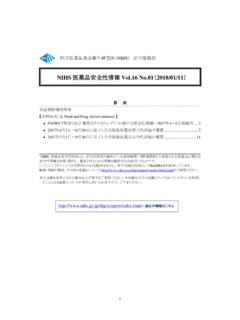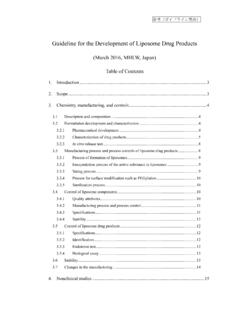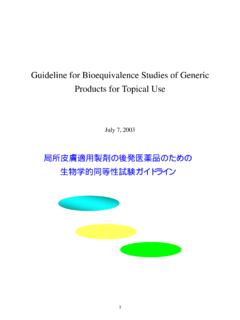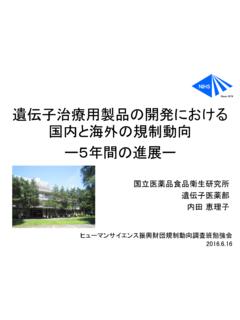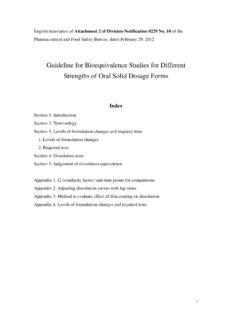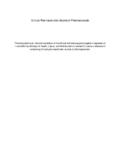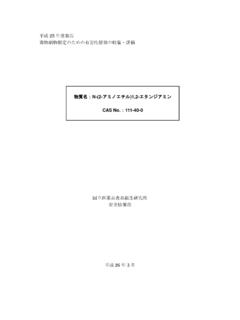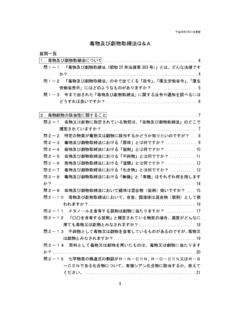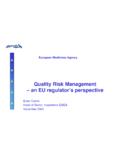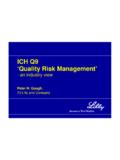Transcription of Risk Assessment and Management of Genotoxic Impurities in ...
1 Risk Assessment and Management of Genotoxic Impurities in PharmaceuticalsMasamitsu Honma, of Genetics and Mutagenesis,National Institute of Health Sciences, Tokyo, JAPANBase+toluenePd catalyst/ Ligand1) conc H2SO4 LiOt-Bu THF1) NaBH4 / MgCl2 /MeOHF3 CXCNNH2F3 CNHCNF3 CNHONH2F3 CNHONHOO2) aqHClF3 CNHHNOOF3 CNHNOOOOS odium carbonate TetrahydrofuranClOOF3 CNNOOOOF3 CCF3 BrF3 CCF3 Methylene chlorideNaOH/TBAB1)2) Ethanol/water2) Ethanol/water1)Step 1 Step 2 Step 3 Step 4 Step 5 Step 6 ClOOX=Cl, Br3) Ethanol/water2) toluene/heptane(1)(2)(3)(4)(5)Synthetic route of Drug Substances(By-Products)Degradation from Drug Substances(Degradants)What is Genotoxic impurity?ImpuritiesGenotoxic or non- Genotoxic ?
2 The International Conference on Harmonisationof Technical Requirements for the Registration of Pharmaceuticals for Human Use (ICH)The ICH is an initiative undertaken by three regions, the European Union, Japanand the United States, with six co-sponsors European Union (EU) US Food and Drug Administration (FDA) Japanese Ministry of Health, Labour and Welfare (MHLW) European Federation of Pharmaceutical Industries and Associations (EFPIA) Japan Pharmaceutical Manufacturers Association (JPMA) Pharmaceutical Research and Manufacturers of America (PhRMA)ICH Quality Guidelines on Pharmaceutical Impurities ICH Q3A: Guidelines on Impurities of new drug substances ICH Q3B: Guidelines on Impurities in new drug productsDrug substance 2g> or 1 mg, whichever is daily doseQualification Threshold Drug product<10mg10 100 mg> 100 mg 2 g>2g1% or 50 g, whichever is or 200 g, whichever is or 3 mg, whichever is issue in ICH Q3A/B (1)In Q3B; It is permitted if a drug product (2g/day) contains impurity.
3 In maximum, 3mg/day ( of impurity is mg/kg/day of DMN can produce liver tumor in 50% of this guideline is not intended to apply during the clinical research stage of development, in the later stages of development the thresholds in this guideline can be useful in evaluating new Impurities observed in drug substance batches prepared by the proposed commercial process. An issue in ICH Q3A/B (2)7. QUALIFICATION OF Impurities (Q3A) 2006/ 6 EMEA2008/ 12 FDAEMEA and FDA guideline for Genotoxic impuritiesNo guideline for Genotoxic Impurities in the development of pharmaceuticals in ICH The ICH steering committee approved to make ICH Genotoxic impurity guideline on June 2010.)
4 The ICH-M7 EWG started to discuss this topic from Fukuoka, on November 2010. ICH M7 draft guideline (Step2) were completed in San Diego, on November : Assessment and Control of DNA-Reactive (Mutagenic) Impurities in Pharmaceuticals to Limit Potential Carcinogenic RiskMajor Safety Issues of ICH Guideline for Genotoxic Impurities The focus of this guideline is on DNA reactive substances which can be detected by Ames assay. Application of Threshold of Toxicological Concern (TTC) to control Genotoxic Impurities . Risk Assessment for patients and healthy volunteers during clinical development. Evaluation of genotoxicity of Impurities using the Structure Activity Relationship (SAR).
5 Risk mitigation considering exposure duration and hazard Principles The focus of this guideline is on DNA reactive substances that have a potential to directly cause DNA damage when present at low levels leading to mutations and therefore, potentially causing cancer. This type of mutagenic carcinogen is usually detected in a bacterial reverse mutation (mutagenicity) assay. Other types of genotoxicants that are non-mutagenic typically have threshold mechanisms and usually do not pose carcinogenic risk in humans at the level ordinarily present as doseDoseResponseGenotoxicNo thresholdSafety dose DoseResponseRegardless of genotoxicityVirtually safety dose(VSD)Thresholds of Toxicological Concern (TTC) Grounds for Calculating TTCB ased on the hypothesis that carcinogenicity is a toxic endpoint having the highest sensitivity, TTC is calculated from the analysis of distribution of the TD50 data, obtained from the Carcinogenic Potency Database (CPDB).
6 Unit risks used in actual risk evaluations are calculated via the fitting of mathematical models, such as linear or multi-stage models. VSD (10-5 - 10-6 risks) is calculated by the linear extrapolation from TD50, and its distribution is (LMS)VSD(TD50)Multi-Stage ModelLinear extrapolation from TD50 Tumor (LMS)VSD(TD50)Multi-Stage ModelLinear extrapolation from TD50 Log10 DoseRelative FrequencyDistribution of TD50 Distribution of VSD(10 6from TD50) ug/day( ug/kg/day)85 % ileLog10 DoseRelative FrequencyDistribution of TD50 Distribution of VSD(10 6from TD50) ug/day( ug/kg/day)85 % ile63 % g/dayVSD with 10-5risk ( g/person/day ) = Weight (kg) X TD50( g/kg)/50,000TD50 of mg/kg/day corresponding to the VSD of g/day.
7 TTC g/person/day g/kg bw/day 10-6carcinogenic risk Genotoxic carcinogens contained in foods Excludes important cohorts (Cohort of Concern; COC) g/person/day g/kg bw/day 10-5carcinogenic risk. Non- Genotoxic carcinogens contained in foods Genotoxic carcinogenscontained in drugs as Impurities Excludes important cohorts (Cohort of Concern; COC)Cohort of Concern (COC)1. Aflatoxin-like compounds2. Azoxy compounds3. Nitroso compounds4. 2, 3, 7, 8-dibenzo-p-dioxin and its analogs (TCDD)5. SteroidsHazard AssessmentsI. ClassificationII. SAR analysisIII. Ames vivo follow-upI. ClassificationImpurity classDefinitionGuidance for controlClass 1 Mutagenic CarcinogensClass 2 Alert structure-unique and unknown mutagenic potentialClass 3 Mutagenic, but carcinogenicity unknownClass 4 Alert structure-non-unique and qualified in comparison to APIC lass 5No structure alertVSD, TCCor PDEQ3A, Q3 BII.
8 SAR AnalysisICH-M7(Step2 Document)A computational toxicology Assessment should be performed using (Q)SAR methodologies that predict the outcome of a bacterial mutagenicity assay. Two (Q)SAR prediction methodologies that complement each other should be applied. One methodology should be expert rule-basedand the second methodology should be statistical-based. The absence of structural alerts from two complementary (Q)SAR methodologies is sufficient to conclude that the impurity is of no concern, and no further testing is required.(Q)SAR SystemsDEREKO ncologicToxtreeOECD Tool BoxMulti-CASELSMA (Leadscope)MDL-QSAR(SciQSAR)ADMEWORKS Hybrid-TypeOASIS/TIMES (Optimal Approach Based on Structural Indices Set/ Tissue MEtaboliteSimulator)RULE-BASESTATISTICAL -BASES utter et al.
9 , Use of in silico system and expert knowledge for structure-based Assessment of potentially mutagenic Impurities . Regul. Tox. Pharma., 2013 (PhARMA White paper)Combination of Two (Q)SAR Tools to Predict Ames Mutagenicity CompanyA608 chemicals 25 positive B269 chemicals 14 positive C119 chemicals 31 positive Sensitivity (%)448372777797100 Specificity(%)784770696962 QSART oolsDEREK+McaseDEREK+Mcase+LSMADEREK+Mca seConcordance(%)69567067693433 III. Ames TestICH-M7(Step2 Document)To follow up on a structural alert, an Ames mutagenicity test can be applied. An appropriately conducted negative Ames test would overrule any structure-based concern, and no further genotoxicity assessments would be required.
10 These Impurities should be managed and controlled as ordinary Impurities according to ICH Q3A/Q3B. A positive Ames result would warrant further risk characterization and/or control measures. IV. In Vivo Follow-upICH-M7(Step2 Document)In order to understand the relevance of the Ames assay result under in vivoconditions, it is recommended that the impurity is tested in anin vivogene mutation assay. The selection of other in vivogenotoxicity assays should be scientifically justified based on knowledge of the mechanism of action of the impurity and its organ site of contact (Note 3). In vivotest Mechanistic data to justify choice of test as fit-for-purposeTransgenic mutation assays For any bacterial mutagenicity positive.
